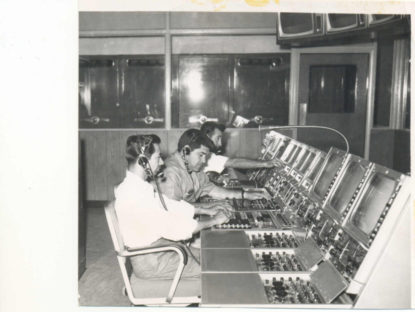Broadcast engineering managers who get hired from outside the company have to spend some time becoming familiar with the plant. Not so with Fred Swift, who took over as Chief Engineer at KUSI after 29 years of building much of the facility. Fred succeeds Richard Large, who retired February 1st.
Like most older broadcast engineers, much of Fred’s knowledge is self-taught. “I took ROP electronics Junior and Senior year of high school at Santana. I got up at 5AM everyday to catch the bus to Santana from Mt. Miguel. I got my [Third Class] FCC License at 16, had an A.S. equivalent when I graduated high school, then worked at Conic Data Systems about a year on L-band FM video transmitters. A guy in the calibration lab told me about a job at KCST-TV (now KNSD). I applied, and Tom Wimberly, the chief then, hired me. That’s when Richard and I met. Tom hired Richard from WAND-TV. He came in about a year after me and left after a couple of years to work in Philly at WPHL-TV. Then He was Hired to put KUSI on the air.
“A lot of my education was self-taught. The most beneficial part was freelance work. I’ve done Atlanta Olympics, two Super Bowls, Oscars red carpet wireless HD cameras, New York Marathon, NBC Golf, etc. Those shows teach you a lot technically and a lot about your abilities and confidence.”
When Fred started at KUSI in 1984, the station was outfitted as an RCA package of 1/2″ reel VTRs, Plumbicon cameras, telecine, Grass Valley switcher, and big TVU-55 UHF transmitter. But Fred embraced change and taught himself the technologies necessary to eventually integrate high definition file-based streaming and transmission systems. You always see him at local high tech seminars.
At channel 39, Fred met his wife who continues as Production Manager at KNSD after 36 years. They have one son Daniel who is a student and works at Sea World.
When asked about career highlights, Fred mentions moving to Viewridge Avenue location and starting newscasts in 30 days. More recently, their conversion of master control and news studio to HD. The trademark of KUSI is their low-cost, high local content news with its many live on-location shows, and Fred was always part of those behind the scenes.
Fred and Richard battled the effects of the 2003 Cedar and 2007 Harris and Witch Creek fires, when their ENG relay sites were going down one by one, backup generators running out of fuel, phone lines failing, burnt telephone poles falling.
During the 2007 Harris fire, the Mt. San Miguel site Proscan antenna rotator stopped turning. “It was the only site still up for us. I was at Jamacha junction watching the site at midnight from below, on the phone with Richard telling him it looks like the fire went past our site and south west toward Otay Ranch because some genius thought a back fire in Proctor valley was a good idea.
“Richard and I went to Miguel around 9 AM (the next morning) and wanted to go to our site. We were stopped by US Forest Service brush truck with four firefighters. We requested they escort us up to the site. Their reply was, ‘No way—it’s too dangerous—but you can go by yourselves!’
“We got up to site through fire tornadoes in the canyons. It was very surreal, like the moon. Scorched earth and dead wildlife everywhere. We entered our site and found the cable company building collapsed, still smoldering. We went to our building and noticed our roof cap was smoking pretty well. I called our assignment desk to have CDF come up and put some water on the fire. [CDF] basically said, ‘You’re on your own.’
“Richard got the ladder out. I found a five gallon bucket and some RG-59 for a rope, and I bucket brigaded water up to him on the roof and we put it out ourselves. We fixed the bad relay in the Troll [controller] and came back to studio. Wow–what week that was!”
In spite of their tight budgets, Fred and Richard managed an almost complete upgrade to high definition video. Their current news operation uses JVC GY-HM-700’s that output .MOV files directly to Apple Final Cut Pro. They play out video with a Bitcentral system.
Their channel 18 ATSC transmitter is a Harris Diamond Solid State with Apex exciters. Fred says that next on the horizon is a bonded cellular field video transport backpack system.
KUSI is looking for an Assistant Chief Engineer. And no, you don’t have to commit to 29 years.


